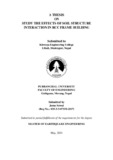Please use this identifier to cite or link to this item:
https://elibrary.khec.edu.np:8080/handle/123456789/745Full metadata record
| DC Field | Value | Language |
|---|---|---|
| dc.contributor.advisor | Er. Sudip Karanjit | - |
| dc.contributor.advisor | Dr. Chandra Kiran Kawan | - |
| dc.contributor.author | Suwal, Jeena | - |
| dc.date.accessioned | 2024-07-17T09:28:36Z | - |
| dc.date.available | 2024-07-17T09:28:36Z | - |
| dc.date.issued | 2024-05 | - |
| dc.identifier.uri | https://elibrary.khec.edu.np:8080/handle/123456789/745 | - |
| dc.description.abstract | The interaction between the soil and the structure is crucial to the building’s dynamic performance. This study compares the dynamic response of a structure resisting on a fixed basis with a structure resting on a flexible base that models the spring support in order to better understand the seismic performance of the superstructure while taking soil-structure interaction into account. Testing for ambient vibration was done to find out how stiff and functional the building really is. This thesis explores the complex dynamics of soil- structure interaction (SSI) in reinforced cement concrete RCC building. Study focuses on how variation in soil properties and foundation design influence the structural performance. The study employs a combination of numerical modelling and experimental validation to analyze the behavior of RCC buildings. Advanced finite element tool is used to simulate the interaction between soil and structure incorporating the spring with soil stiffness. Two buildings one residential and the other institutional are chosen for this investigation. Analysis is done for fixed base condition for both type of building then, for the flexible base condition. Modeling a point spring and computing the spring’s stiffness using different relations, SSI is taken into consideration. SSI is considered for different type of soil and also for different type of ground motion. Tests of ambient vibration have been conducted to comprehend the dynamic response of the structure. The study highlights how crucial it is for SSI to offer insightful advice during the structure’s design and analysis. The results of the investigation show that time elongates with SSI and decreases in soil stiffness. The displacement of storeys also exhibits this same pattern. Studies highlight the significance of the SSI in providing a thorough comparison between various soil conditions and parameters. The research aids in the field of civil engineering by providing a deeper comprehension of the soil-structure interaction (SSI) in reinforced concrete buildings, as well as improved structural analysis and design. | en_US |
| dc.language.iso | en_US | en_US |
| dc.relation.ispartofseries | ;(Reg No.: 035-3-3-07338-2017) | - |
| dc.subject | Ambient Vibration test, Equivalent spring support, Soil stiffness, Soil Structure interaction | en_US |
| dc.title | STUDY THE EFFECTS OF SOIL STRUCTURE INTERACTION IN RCC FRAME BUILDING | en_US |
| dc.type | Thesis | en_US |
| local.college.name | Khwopa Engineering College | - |
| local.degree.department | P. G. Department of Earthquake Engineering | - |
| local.degree.name | ME Earthquake | - |
| local.degree.level | Masters | - |
| Appears in Collections: | Master of Science (M.Sc) in Earthquake engineering | |
Files in This Item:
| File | Description | Size | Format | |
|---|---|---|---|---|
| 017_Jeena Suwal.pdf Restricted Access | 3.97 MB | Adobe PDF |  View/Open Request a copy |
Items in DSpace are protected by copyright, with all rights reserved, unless otherwise indicated.
